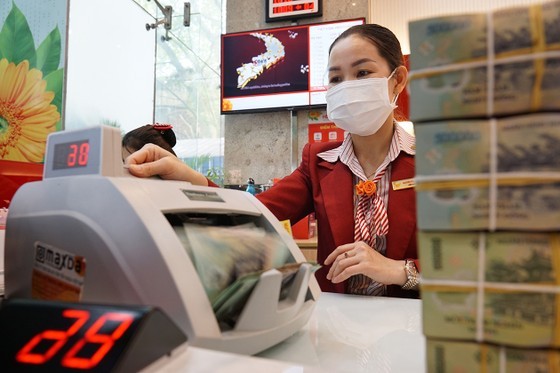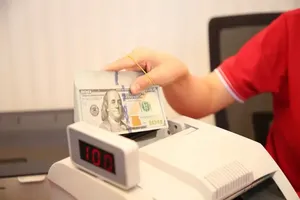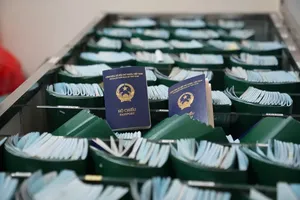 |
An bank employee is checking the money deposited by a customer |
Profit erosion
The latest report from the State Bank of Vietnam (SBV) reveals that as of the end of February 2023, the non-performing loans (NPLs) across the entire banking system reached approximately 3 percent, double the level at the end of 2021. The overall gross NPL ratio for the banking system has now risen to 5 percent. Among them, statistics from 27 listed commercial banks on the stock exchange indicate that as of March 31, the total domestic NPLs exceeded VND170.5 trillion, marking a 24.3 percent increase compared to the beginning of the year.
Furthermore, a significant number of commercial banks have NPL ratios that surpass the 3 percent threshold set by regulations. Specifically, NCB has an NPL ratio of up to 23 percent, VPBank 6.24 percent, BaovietBank 4.69 percent, and VIB 3.64 percent. Experts predict that the risks associated with banking NPLs will continue to rise as the real estate and corporate bond markets have yet to recover, both of which are sectors with high NPL ratios.
In reality, despite many commercial banks reporting decent profits in a challenging economic environment, the financial reports for the first quarter of 2023 from the 27 listed commercial banks on the stock exchange show a 4.4 percent decrease in profits compared to the same period, mainly due to the need to significantly increase provisions for risk management. This indicates that high levels of bad debts have eroded bank profits.
Specifically, due to the increase in NPLs, VPBank had to raise provisions for risk management by 55 percent, resulting in a 77 percent decline in profits in the first quarter of 2023. Similarly, Techcombank experienced a 17 percent decrease in profits in the first quarter of 2023 due to doubling provisions for risk management to VND534 billion compared to the same period.
On the other hand, VietinBank achieved a 3 percent growth in profits in the first quarter of 2023 due to a 52 percent increase in provisions for risk management. BIDV, in particular, reduced provisions for risk management by 25.2 percent, leading to a significant increase of 58 percent in pre-tax profits.
Interestingly, some banks reduced provisions for risk management to "beautify" their profits, despite a surge in bad debts. For example, although Eximbank's total bad debts increased by 30 percent in the first quarter of 2023 compared to the beginning of the year, a 42 percent reduction in provisions for risk management (about VND66 billion) led to an 8 percent increase in pre-tax profits compared to the same period.
Dr. Can Van Luc, Chief Economist of BIDV, indicated that in 2022, the average profit growth of 29 commercial banks reached 34 percent. However, the projected profit growth for banks in 2023 is expected to be only 13-15 percent. "Despite the proactive and determined efforts of the Government, SBV, and relevant ministries and agencies to implement policies supporting businesses, the forecast for NPLs in the credit system suggests that they may continue to increase in 2023," said Dr. Can Van Luc.
Restructuring debts with caution
In response to the growing burden of high levels of bad debt in the financial system and to provide support to individuals and businesses facing challenges, the SBV issued Circular No.02/2023 on debt restructuring at the end of April 2023.
Accordingly, commercial banks are permitted to extend the repayment period, defer payments, and maintain the current debt classification for up to 12 months for debts and interest payments of individuals and businesses experiencing financial difficulties. Given the constrained market conditions with reduced outputs, declining revenues, and fewer orders, this circular has generated optimism among businesses.
However, many commercial banks have expressed that they will only consider debt restructuring for businesses that have the potential to recover, as banks bear responsibility for their decisions in the debt restructuring process. If credit conditions are relaxed, the difficulties faced by businesses could be transferred to the banks.
Furthermore, according to a representative from OCB, the debt restructuring mechanism implemented this time differs from the one implemented for customers affected by the Covid-19 pandemic. Circular No.02 requires commercial banks to allocate provisions for the restructured debts, taking into account the varying financial resources of each bank. Therefore, banks will proceed cautiously, carefully evaluating customers for debt restructuring while implementing measures to recover debts and limit the volume of NPLs.
Economist and Assoc. Prof.-Dr. Dinh Trong Thinh raises concerns about the potential risks associated with allowing debt extensions under Circular No.02 issued by the SBV. He believes that there is a high possibility of these extended debts becoming NPLs once the circular's effectiveness expires. However, despite these concerns, the SBV's directive for banks to allocate provisions and fulfill other requirements also mandates that banks develop suitable response strategies to address the situation.
Stringent measures to address delayed debt restructuring for customers
The SBV’s Governor has recently issued Directive No.02, which directs credit institutions and their branches to strictly enforce the policy of debt restructuring and maintaining debt groups to support customers facing difficulties, as outlined in Circular No.02/2023. In line with this directive, commercial banks are strongly encouraged to promptly establish and implement internal regulations on debt restructuring and the maintenance of debt groups following the prescribed guidelines. Any actions that create obstacles, cause inconvenience, or impose additional conditions and procedures beyond the provisions of Circular No.02/2023 are strictly prohibited.
According to Mr. Nguyen Quoc Hung, General Secretary of the Vietnam Banking Association (VNBA), from August 15, 2017, the effective date of Resolution No.42/2017 on NPL resolution, to the end of January 2023, the entire banking system has successfully resolved NPLs totaling VND416 trillion, as defined by Resolution No.42/2017. Of this amount, the resolution of on-balance sheet NPLs reached VND211.9 trillion, accounting for 50.9 percent of the total NPLs. Additionally, the resolution of off-balance sheet NPLs amounted to VND122.1 trillion, representing 29.3 percent of the total NPLs.
Real estate investors face obstacles
A survey conducted in the early months of 2023 by the real estate trading platform Batdongsan.com with 1,000 individuals revealed that not only those who do not own properties are interested in acquiring real estate, but also individuals who already own three or more properties still have a strong desire to make additional purchases. This group accounted for an astounding 87 percent of the respondents.
Similarly, for individuals who own 1-2 properties, the desire to continue acquiring assets was reported at 66-79 percent respectively. Notably, a significant number of individual real estate investors rely on credit as a source of funding. Consequently, with loan interest rates ranging from 13 percent to 15 percent per annum, many investors find themselves coming to a stall.
For instance, Nguyen Dung, residing in District 3, HCMC, owns multiple assets, including residential and agricultural land in Binh Duong, Long An, and Lam Dong provinces. However, he constantly finds himself in need of cash to repay his debts. Each month, he has to allocate nearly VND200 million to repay both the principal and interest to the bank. This includes a VND6 billion loan that has received warnings from the bank as it could potentially turn into a bad debt.
Over the past five months, Dung has resorted to leveraging his house and car, borrowing from relatives, and even taking out high-interest loans to cover the interest payments because his five land title deeds on the outskirts of HCMC remain unsellable, despite lowering the prices.
Similarly, another real estate investor residing in Thu Duc City had to sell his luxury car, imported from Europe in 2018, at a reduced price to repay a loan taken to purchase more than 6,000 square meters of agricultural land in Dong Nai Province. Despite repeated price reductions, he has been unable to find a buyer for the land.
This is the inevitable result of speculative and short-term trading investment practices, excessive use of financial leverage during the real estate market boom, and the failure to react promptly when the market turned sour for an extended period. R
egarding this situation, Ms. Duong Thuy Dung, Senior Director of CBRE Vietnam, believes that although credit policies are gradually being relaxed, accessing capital for investors remains extremely difficult. Moreover, the future development of the real estate market is still uncertain. The fact that whether the market will heat up or not depends greatly on global and domestic economic conditions. Consequently, finding a viable solution for investors stranded with their accumulated assets remains a formidable challenge.
















)

)





